
Author: Do Dive, DeSpread Research
Disclaimer: The content of this report reflects the views of the respective authors and is for reference only and does not constitute a recommendation to purchase or sell tokens or use the agreement.Nothing in this report constitutes investment advice and should not be construed as investment advice.
1. Overview of liquid staking services
In blockchain networks that use Proof of Stake (PoS) consensus algorithms or similar mechanisms (such as Ethereum), in order to participate in the block verification process, a certain number of native tokens must be bet.While betting takes up a lot of money, thus enhancing the security of the chain, it also brings up a problem that betting funds cannot be used elsewhere, resulting in reduced fund efficiency.
Liquidity staking is launched to solve this problem. It provides services that allow subscribed assets to be liquidated and participate in the block verification process without losing liquidity.Liquid staking services usually provide users with the following functions to free up the capital efficiency of pledged assets:
-
Tokenization of collateral assets: When a user pledges the assets through liquid pledge services, he or she will receive derivative tokens corresponding to the pledged assets (such as stETH).
-
Value Guarantee and Reward Distribution: Derivative Tokens Guarantee can be exchanged 1:1 with the underlying assets.Holders of these tokens can receive block verification rewards through mechanisms such as reset or exchange rate adjustment.
-
Liquidity and asset utilization: Users can leverage the value of derivative tokens in various decentralized applications (dApps), such as using it as loan collateral or providing liquidity in DeFi scenarios.
There are great barriers to entry to participating in block verification on certain chains.For example, becoming an Ethereum verifier requires 32 ETH (valued over $10,000) capital, and Solana has to bear high hardware costs because of the high specifications of the chain.
Liquid staking services solve these obstacles by allowing more users to participate in the block verification process, bringing benefits to both the chain and the user, including:
-
Improve security: Staking more native tokens to enhance the security of the chain.
-
Improve capital efficiency: Users earn block verification rewards while using collateral assets in DeFi.
1.1. The role of liquidity pledge
Lido Finance was launched in December 2020 and is a pioneer in liquid staking services in the Ethereum ecosystem.In April 2023, after the upgrade of Ethereum Shanghai, it realized the function of extracting ETH on Beacon Chain.With the recovery of the market, the number of ETH fixed-invested through liquid staking services has increased dramatically.

Source: @hildobby dune dashboard
According to the dune dashboard provided by hildobby, after the Shanghai upgrade, about 15.8 million ETHs were hosted as of the end of July 2024, exceeding the 13.6 million ETHs before the upgrade.Considering that the Ethereum mainnet was launched in 2015, these numbers prove that demand for Ethereum staking increased dramatically in the 15 months after the Shanghai upgrade.In addition, currently about 32.6% of Ethereum staking is processed through liquid staking services, highlighting the important role these services play in the on-chain ecosystem.

All protocols TVL trends, source: Defilama

Liquid staking TVL trend, source: Defilama
According to DefiLlama, liquid staking services account for more than half of the total locked value (TVL) of all protocols, which shows its dominance.The Lido Finance family owns the highest TVL of all agreements, at about $32.7 billion.
Key indicators as of August 1, 2024:
-
Total TVL: $99.16 billion
-
Liquidity staking TVL: US$50.7 billion
-
Lido Finance TVL: $31.2 billion (ranked first among all agreements, second place is EigenLayer at $15.5 billion)
-
Ethereum staking: approximately 34 million ETH
-
Liquid capital utilization rate: approximately 11 million ETH (32.6% of the total ETH stake)
1.2. Applicability to other chains
The success of liquid staking services on the Ethereum chain has stimulated adoption of other chains, including Solana, Avalanche and IBC-based chains.Some of these services have also achieved considerable TVL, proving their usefulness.Following Ethereum, Solana has become the second largest chain of liquid staking services, with notable protocols including:
-
Jito/TVL: $1.84 billion
-
Marinade/TVL: $1.1 billion
-
Sanctum / TVL: $758 million
These developments show that the influence of liquid staking services is expanding in different blockchain ecosystems.
2. Stacks’ transfer certificate (PoX) and liquidity stake
Even a chain without a Proof of Stake (PoS) mechanism can create a favorable environment for liquid staking protocols if part of its consensus mechanism involves the process of token locking or delegating to validators.Stacks using the Transfer Proof (PoX) consensus mechanism is an example of this.
The PoX algorithm in the Stacks blockchain is characterized by the interaction between miners and Stacker.Miners send Bitcoin (BTC) to Stacker to gain the right to create Stacks blocks and get STX rewards.Stacker needs to lock a certain number of STX to get BTC rewards.For more details, see “Stacks Nakamoto Upgrade, a Butterfly Ready to Stand Out”.
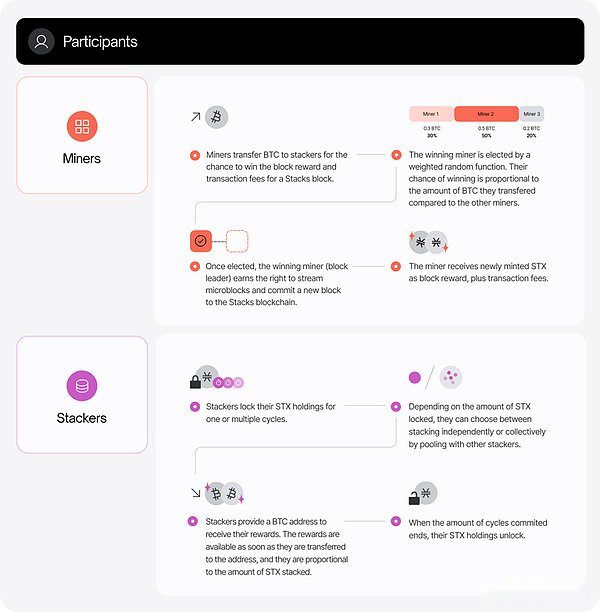
The role of miner and Stacker, source: stacks docs
At the beginning, Stacker only needs to lock in STX tokens to participate in the PoX process, however, after the Nakamoto upgrade scheduled for the second half of this year, Stacker will play a new role called Signer.Signer will be responsible for verifying, storing, signing and spreading Stacks blocks generated during the miner’s tenure.
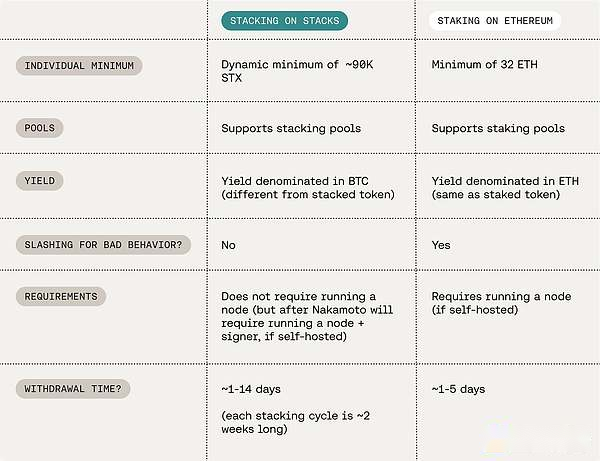
Stacking vs Staking, Source: Hiro blog
As shown in the figure, the “Stacking” process in Stacks has similarities with the “Staking” process in Ethereum: 1) Both involve locking tokens to participate in the consensus mechanism on the chain; 2) Both require a lot ofThe native token, and after Nakamoto is upgraded, Stacker also needs the node operation, creating entry barriers; 3) Both need to lock assets within a certain period of time and set up a withdrawal period to reduce capital efficiency, which highlights the convergence of currentsRequirements for staking services.
3. Liquid staking service: StackingDAO
3.1. The role of Stacking mechanism and StackingDAO
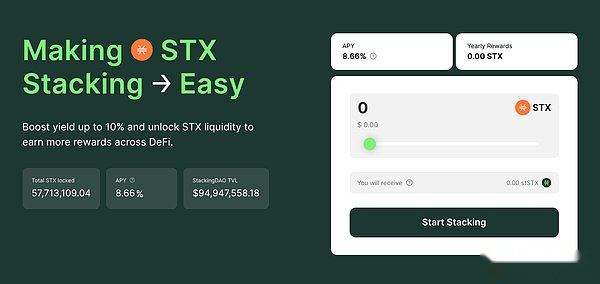
Source: StackingDAO
StackingDAO is a decentralized application (dApp) that provides liquid staking services for Stacking processes on Stacks.Similar to other liquid staking services, users can deposit their STX tokens into StackingDAO, participate in the Stacking process, and earn approximately 8% (7% of the benchmark) annual rate of return (APY) by obtaining derivative tokens from stSTX (APY).).
The Stacking mechanism on Stacks is similar to Ethereum’s staking process, both introducing difficult entry thresholds:
-
Stacking Cycle: Stacking takes two weeks as a cycle, resulting in locking, unlocking, and re-Stacking having time limits.
-
Minimum STX requirements: Registering as Stacker requires at least about 90,000 STX tokens.
-
Node operation: After Nakamoto is upgraded, Stacker needs to run nodes.
A two-week cycle brings time inconvenience to users because they have to lock or unlock their assets according to the cycle.In addition, if the user wants to unlock only some assets, he must first unlock all assets and then re-lock the rest, adding complexity.
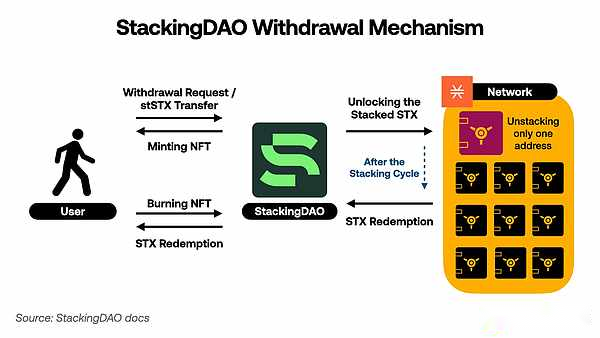
To address these challenges, StackingDAO has designed an exit mechanism that lowers the entry threshold and also reduces the impact on Stacking yields, with its main features including:
-
Diverse Stacking Addresses: StackingDAO assigns STX to 10 different Stacking addresses to mitigate the impact on yield.
-
Interleaving: Only one of 10 addresses is unlocked per Stacking cycle, allowing staggered withdrawals according to user requirements.
-
Issuance of NFTs: When users request withdrawals, they send stSTX to the protocol, which issues NFT as receipt.After the Stacking cycle ends, users can burn NFTs to redeem unlocked STX tokens.
This mechanism reduces time constraints and inconveniences in the Stacking process, ensuring that users can acquire and use assets more flexibly while maintaining Stacking revenue.
3.2. Growth and Key Indicators
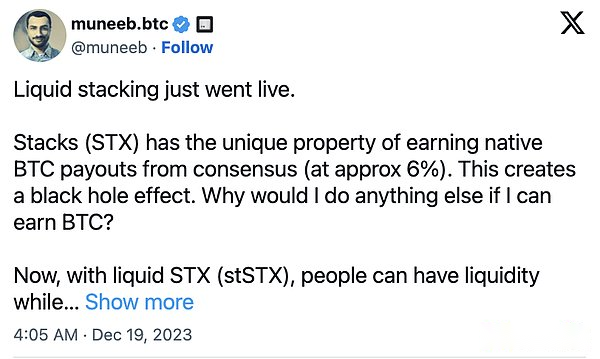
Muneeb announces StackingDAO, source: Muneeb X
Since its launch in December 2023, StackingDAO has effectively won attention by introducing a points system and attracts rapid growth of users and capital.The points system rewards users every day based on the stSTX held by the user, encourages stSTX to be hooked to STX and is used in the DeFi protocol:
-
Reward 1 point for every 1 stSTX token held
-
Rewards of 1.5 points per stSTX token deposited into the DeFi protocol
-
Rewards of 2.5 points per stSTX token deposited into Bitflow stable exchange pool
Key indicators as of August 21, 2024:
-
Total stSTX volume issued: approximately 56.8 million
-
DeFi utilization of stSTX: 45%
-
stSTX TVL in DeFi: $36.78 million
-
Total points issued: approximately 14.95 billion
-
Total number of users: 37,498
StackingDAO, the first liquid staked dApp in the Stacks ecosystem, reached a TVL peak of nearly $125 million shortly after its launch.Despite market adjustments, StackingDAO’s TVL remained at around $80 million, making it the most funded dApp in the Stacks ecosystem.
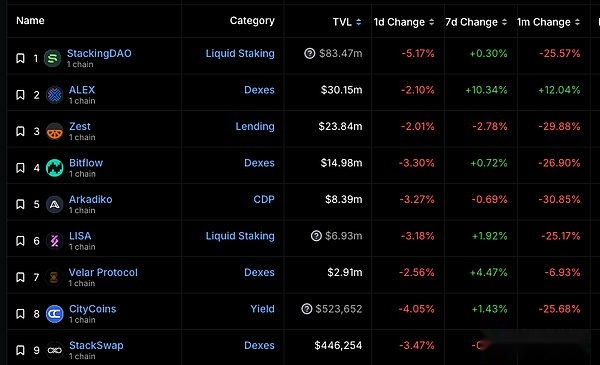
Stacks dApp TVL Ranking, Source: Defilama
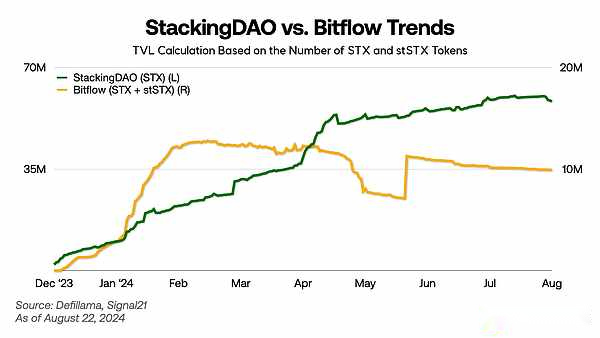
Bitflow is a stable trading protocol necessary to provide stSTX value maintenance and also benefits from the introduction of StackingDAO and the introduction of points systems.Currently, approximately 10.5 million STX tokens are stored in the agreement, highlighting its growth momentum.
StackingDAO TVL, calculated in STX tokens, has been on an upward trend since its launch and has now deposited approximately 58.6 million tokens.This accounts for about 4% of the total 1.48 billion STX circulation supply, and also about 13% of the 425 million STX tokens currently involved in Stacking, which is a considerable number given that the dApp is less than a year old..
3.3. Contribution to Stacks Network: StackingDAO V2
Starting from late August, as the activation phase of the Nakamoto upgrade is fully unfolding, Stacker will transition to the Singer role responsible for validating the Stacks block.Signer is similar to the verifier in the Proof of Acceptance (PoS) chain, so enhancing the stability and diversity of the Signer network has become a key goal for improving the security and decentralization of Stacks blockchain after Nakamoto upgrades.
Against this backdrop, StackingDAO launched StackingDAO V2, aiming to simplify the Signer joining process.A key feature of this update is the delegation of the STX tokens deposited into StackingDAO to new signers on the Stacks blockchain, thereby facilitating the growth of the network.The update was originally announced in March and is scheduled to be implemented after the Nakamoto upgrade is completed.
StackingDAO V2 is built around a mechanism for user-stated STX tokens authorized proportionally based on Signer’s performance. The design aims to achieve the following goals:
-
Improve network performance: Delegate the STX stake to different Signers to enhance the diversity of the Signer network and incentivize Signers to improve performance.
-
Improve user income: More STX pledges will be delegated to higher performance Signers, thereby providing users with higher superimposed returns.

Signer status that has been joined by StackingDAO, source: StackingDAO
Even now before the Nakamoto upgrade is fully activated, 10 entities (excluding StackingDAO) have joined StackingDAO’s Signer program, and delegated amounts have been allocated to these Signers since May.After the Nakamoto upgrade is released, the scope of joining Signer through StackingDAO is expected to expand, which will further enhance the diversity of the Signer network.
4. Conclusion
As interest in the Bitcoin ecosystem surged early this year, the Stacks network and other projects also received great attention together.This focus has driven the growth of the Stacks network’s total locked value (TVL), peaking at $180 million in April, an increase of 18 times compared to the $10 million TVL recorded in September the previous year.
However, as the market enters the adjustment stage, a series of challenges within the Stacks ecosystem have occurred.These include delays in Nakamoto’s upgrade, as well as hacking incidents in Alex, the largest decentralized exchange in the Stacks ecosystem.Despite these setbacks, emerging projects such as StackingDAO, Zest, Bitflow and LISA continue to accumulate TVL and achieve growth, and as Nakamoto upgrades are set to be completed in September, the market is once again optimistic about the future of the Stacks ecosystem.

Source: Hiro blog
The Nakamoto upgrade is about to be implemented, and the evolution of the Stacks ecosystem is worth observing. You can also wait and see how StackingDAO, which has the largest TVL in the ecosystem, will develop.How StackingDAO successfully becomes a liquid magnet in Stacks DeFi will be the key to the coming months.








